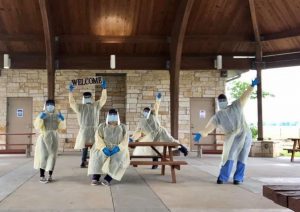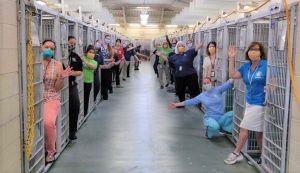Module 7: Get to Know a Shelter
COVID’s Impact on Animal Sheltering – Is it Over?
Animal sheltering had never faced anything like the COVID pandemic before. Like other businesses and public services, shelter operations quickly pivoted to essential functions overnight. Spay/neuter programs were shuttered. Shelter workers and volunteers were unable to work. Shelters braced for pets coming in from families stricken by the virus, not knowing if the pets themselves would be infected.

Cutting back to essential functions necessitated a quick reduction in the number of animals in shelters to minimize bringing personnel together to care for them. Shelters called upon their communities to help by delaying relinquishments, reuniting lost and found animals outside of the shelter system, and mass fostering of shelter pets. Shelter populations plummeted to the lowest numbers ever recorded as community members stepped in to help.
Shelters Empty Out and Flip to Virtual Adoptions

Florida Animal Shelter Celebrates Emptying a Kennel for the First Time Ever
By David Williams and Amanda Jackson
A Florida kennel that’s normally packed with stray and abandoned dogs was filled instead with cheering staff and volunteers because all of the animals have found new homes.
Friends of Palm Beach County Animal Care and Control shared video of the moment on social media this week and said it’s the first time the shelter has emptied one of its three kennels. This video contains applause only, no dialogue.
The kennel has 48 dog runs that often hold two dogs each, according to Elizabeth Harfmann, the community outreach manager for the shelter.
“It’s definitely been a combined effort from the community. The animals went to foster homes, adopters and to our partner rescue organizations,” Harfmann told CNN. “We’ve also seen a decrease in incoming animals, so that has helped as well.”
Many shelters across the nation are seeing a surge in adoption applications from people who have more time to devote to a new pet, since they’re staying at home to slow the spread of the coronavirus pandemic. Read more . . .
The worst of the pandemic has passed, and COVID has now joined seasonal flu, respiratory syncytial virus, rhinovirus, and others as endemic respiratory viruses in circulation. Unfortunately, animal shelters and veterinary clinics have not fully recovered from the pandemic’s impacts.
Since 2020, shelters across the country remain challenged by decreased adoptions and transfers, increased relinquishments, and increased crowding and disease outbreaks. Shelter euthanasia increased for the first time in decades. Length of stay prolonged, especially for big dogs. The pre-existing veterinary workforce shortage was exacerbated, leading unfilled veterinary team positions in up to three quarts of shelters and low-cost clinics. This workforce shortage also created a shortfall of 3.7 million spay/neuter surgeries in 2000-2023, with spay/neuter capacity still lagging behind 2019 levels. The offspring of those animals are likely now having offspring of their own. The shortage of veterinary care, spiraling veterinary costs, and socioeconomic downturns are combining to reduce access to veterinary care, which is increasing pressure on shelters and low-cost clinics to fill the gap.
Lessons From Animal Sheltering in the COVID era
When the national pandemic shutdowns were announced, there was no roadmap for how shelters should respond. At first, it wasn’t known if pets could spread the virus or if it was dangerous for animals control staff to retrieve pets left behind by owners who were hospitalized or died due to COVID. Beginning in late February 2020, national humane organizations, shelter medicine experts, and shelter leaders began meeting daily to share experiences and protocols, to develop guidelines in response to rapidly changing conditions, and to preserve critical functions while staying safe by social distancing. In the early days of the pandemic, the following guidelines were developed to identify the essential functions of animal control organizations in protecting public safety and animal welfare in the face of workforce reductions and the need to slow the spread of the virus. These proved very successful and have served as guides during other large-scale emergencies such as wildfires, hurricanes, and shelter disease outbreaks.

For the safety of our officers and the public they serve, NACA is advising all officers to take extra measures to mitigate the short and long-term effects of the COVID-19 pandemic. These measures include protecting themselves properly to reduce risk of spreading the virus, as well as working to manage and minimize the number of new animals entering our shelters.
As members of the public safety community we have an obligation to perform our sworn duties during disasters both natural and man-made. To that end, NACA recommends the following: High priority/emergency calls: At this time, officers should continue to respond to emergency and high priority calls.
High priority/emergency: Calls include law enforcement assistance, injured or sick stray animals, cruelty and neglect complaints, bite complaints, and dangerous and aggressive dog complaints.
Non-emergency calls and activities: Officers should suspend low priority/non-emergency activity. This includes non-aggressive stray animal pick-up, leash law and licensing complaints, barking and nuisance complaints, trapping and transport of community cats, and conflict mitigation scenarios.
Shelter intake reduction: Animal control agencies should take active measures to reduce non-essential shelter intake. Measures taken should include returning pets in the field instead of impounding them, suspending non-emergency owner surrender intake, and encouraging owners who are ill to keep their pets at home whenever possible.
Personal protective equipment: Animal control officers should be provided with personal protective equipment (PPE) for cases requiring a response to a location with someone who is sick or has been exposed to COVID-19. Officers should make every effort to not enter the home of anyone who is known to have been exposed to the virus.
Data from more than 1,000 animal shelters tracked in the first year of the pandemic revealed that shelter intake plummeted by more than 25%, whereas sending pets to foster homes reached all-time highs. Despite mass media assertions claiming a surge in adoptions of “pandemic puppies,” adoptions were actually down compared to the year before the pandemic, mostly as a result of drastic decreases in intake. Similarly, sensationalized media reports of increased returns of adopted animals to shelters as families return to work and school are not supported by shelter data.

